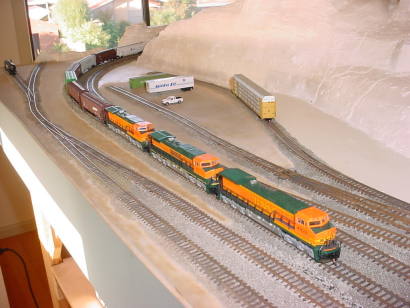Tough Decisions: Rebuild or Keep On Building? 1 of 2
 Monday, January 26, 2009 at 2:08AM
Monday, January 26, 2009 at 2:08AM Here’s the scenario: You get inspired and start building your layout. Trains are running, you’ve carefully worked out the bugs, filed the track nice and smooth, wired it, painted it, ballasted it, weathered it, put in scenery BUT, you’re just not happy with the look of your layout!
What do you do?

This is Chris Martin’s Arizona Mainline N Scale Layout circa April 2007. It’s a decent layout and it stacks up pretty well against other N Scale layouts, but Chris wasn’t happy with it.
Where’s Marto Coming From?
Chris lives in Shepparton in the state of Victoria in Southeastern Australia. Marto and I did N Scale modeling together in the early 1990’s before I moved to the States. We have also done several road trips in the States chasing trains in the southwest.
Chris and I are both really captivated by BNSF’s line from LA to Chicago, particularly the stretches through the Mojave Desert and through Arizona and New Mexico. Being there and seeing the those big GE and EMD warbonnets hitting seventy on the tangent with mile long trains slogging it out in the furnace of the desert just left an indelible impression on both of us.
Hackberry Az
It’s a long way from Shep to Arizona, so Chris set about recreating a slice of the desert mainline in his upstairs train space. His layout is 10’ x 3.5’, a simple double track loop design with the open desert on one side and a small desert town on the other side with some switching possibilities.
As you can see in the lead photo to this post, he’d reached the point of operational track, DCC wiring, ballasting and scenery. Things were moving along steadily, trains were running. Chris was actually further along than most N Scalers, including me. Here’s a short clip of his layout.
As scenery and buildings were added, the layout was taking shape.
Mocking up the industrial area
Pictures of Marto’s original layout construction can be seen here.
But It Just Aint Arizona
The layout just wasn’t capturing the feeling of what we had experienced by the BNSF desert mainline. In order to make sense of what to do about it, Chris felt it was important to understand what wasn’t working on the layout.
Here’s what was bothering Chris:
- The track was Peco code 55, which has the wrong tie length and spacing to effectively simulate US track
- Peco code 55 switches, while reliable, looked very non-US, especially around the throw bar and head-block ties and the tie pattern is also wrong for US models
- The ballast was solid grey instead of the more typical rose color found on the BNSF in the Mojave and parts of Arizona
- The ballast was too course and uneven - the BNSF mainline is typically very well-groomed and well maintained
- The sub roadbed was basically flat and level with the track with very limited options for scenery below track level
- The double track tunnel on one end of the layout looked out of place. There is only one tunnel in the Barstow-Belen stretch of BNSF main. It is known as Nelson Tunnel and is found near Peach Springs Az. The tunnel is isolated and rarely photographed.
- The track configuration in the town was poorly designed (by me!). It didn’t lend itself to switching and bore no resemblance to trackage in towns we had seen.
- The mountain was well carved but dominated the layout. Rather than modeling a mountain with a rail line around it, Chris wanted a rail line running through desert with mountains in the distance much like the prototype setting.
What To Do?
There were two basic choices available to Chris, and neither was a slam dunk:
- Continue on with construction, learn to live with the layout’s shortfalls, and hope that when the layout’s done, the problems that are evident at this point won’t be too noticeable, or,
- Rip out the track and anything else that you’re not happy with and start over.
Before deciding, Chris and I had a fair amount of discussion about the first point - would it be noticeable in the end? Chris concluded that the look of the track was a central element of mainline desert railroading and that it had to look right. No amount of brilliance in the rolling stock, scenery or buildings would overcome poor looking track.
Over the course of a couple of months, he became convinced that the heart of the problem was the combination of 1) incorrect tie size and spacing of the Peco code 55 track and, 2) the course grey ballast which looked nothing like the Arizona mainline.
Chris felt that neither of these would problems would get any better with time. No amount of weathering would help, the prototype track is well maintained and the BNSF ballast rarely gets so dirty that the ties are become obscured. The track clearly had to be redone.
In the next post, I’ll cover Chris’s plan, what we did and how it looks.
- Coxy
P.S. You can contact Chris Martin by clicking here.

Reader Comments